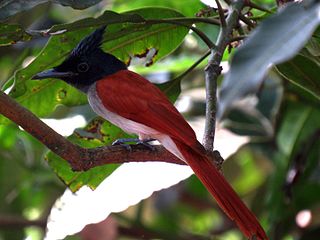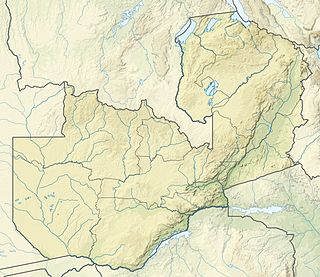Related Research Articles

In biology, taxonomy is the scientific study of naming, defining (circumscribing) and classifying groups of biological organisms based on shared characteristics. Organisms are grouped into taxa and these groups are given a taxonomic rank; groups of a given rank can be aggregated to form a more inclusive group of higher rank, thus creating a taxonomic hierarchy. The principal ranks in modern use are domain, kingdom, phylum, class, order, family, genus, and species. The Swedish botanist Carl Linnaeus is regarded as the founder of the current system of taxonomy, as he developed a ranked system known as Linnaean taxonomy for categorizing organisms and binominal nomenclature for naming organisms.
Genus /ˈdʒiː.nəs/ is a taxonomic rank used in the biological classification of living and fossil organisms as well as viruses. In the hierarchy of biological classification, genus comes above species and below family. In binomial nomenclature, the genus name forms the first part of the binomial species name for each species within the genus.

In taxonomy, binomial nomenclature, also called binominal nomenclature or binary nomenclature, is a formal system of naming species of living things by giving each a name composed of two parts, both of which use Latin grammatical forms, although they can be based on words from other languages. Such a name is called a binomial name, a binomen, binominal name or a scientific name; more informally it is also called a Latin name.

Biodiversity is the biological variety and variability of life on Earth. Biodiversity is a measure of variation at the genetic, species, and ecosystem level. Terrestrial biodiversity is usually greater near the equator, which is the result of the warm climate and high primary productivity. Biodiversity is not distributed evenly on Earth, and is richer in the tropics. These tropical forest ecosystems cover less than ten percent of earth's surface, and contain about ninety percent of the world's species. Marine biodiversity is usually higher along coasts in the Western Pacific, where sea surface temperature is highest, and in the mid-latitudinal band in all oceans. There are latitudinal gradients in species diversity. Biodiversity generally tends to cluster in hotspots, and has been increasing through time, but will be likely to slow in the future as a primary result of deforestation. It encompasses the evolutionary, ecological, and cultural processes that sustain life.

Extinction is the termination of a kind of organism or of a group of kinds (taxon), usually a species. The moment of extinction is generally considered to be the death of the last individual of the species, although the capacity to breed and recover may have been lost before this point. Because a species' potential range may be very large, determining this moment is difficult, and is usually done retrospectively. This difficulty leads to phenomena such as Lazarus taxa, where a species presumed extinct abruptly "reappears" after a period of apparent absence.

The International Union for Conservation of Nature (IUCN) Red List of Threatened Species, founded in 1964, is the world's most comprehensive inventory of the global conservation status of biological species. It uses a set of precise criteria to evaluate the extinction risk of thousands of species and subspecies. These criteria are relevant to all species and all regions of the world. With its strong scientific base, the IUCN Red List is recognized as the most authoritative guide to the status of biological diversity. A series of Regional Red Lists are produced by countries or organizations, which assess the risk of extinction to species within a political management unit.

In biological classification, the term subspecies refers to one of two or more populations of a species living in different subdivisions of the species' range and varying from one another by morphological characteristics. A single subspecies cannot be recognized independently: a species is either recognized as having no subspecies at all or at least two, including any that are extinct. The term may be abbreviated to subsp. or ssp. The plural is the same as the singular: subspecies.

Endemism is the state of a species being native to a single defined geographic location, such as an island, state, nation, country or other defined zone; organisms that are indigenous to a place are not endemic to it if they are also found elsewhere. For example, the Cape sugarbird is found exclusively in southwestern South Africa and is therefore said to be endemic to that particular part of the world.

The conservation status of a group of organisms indicates whether the group still exists and how likely the group is to become extinct in the near future. Many factors are taken into account when assessing conservation status: not simply the number of individuals remaining, but the overall increase or decrease in the population over time, breeding success rates, and known threats. Various systems of conservation status exist and are in use at international, multi-country, national and local levels as well as for consumer use.

Holcocera is a gelechoid moth genus of the family Blastobasidae. There are about 70 described species.

In biological classification, taxonomic rank is the relative level of a group of organisms in a taxonomic hierarchy. Examples of taxonomic ranks are species, genus, family, order, class, phylum, kingdom, domain, etc.

An endangered species is a species that is very likely to become extinct in the near future, either worldwide or in a particular political jurisdiction. Endangered species may be at risk due to factors such as habitat loss, poaching and invasive species. The International Union for Conservation of Nature (IUCN) Red List lists the global conservation status of many species, and various other agencies assess the status of species within particular areas. Many nations have laws that protect conservation-reliant species which, for example, forbid hunting, restrict land development, or create protected areas. Some endangered species are the target of extensive conservation efforts such as captive breeding and habitat restoration.

Female is the sex of an organism that produces the large non-mobile ova, the type of gamete that fuses with the male gamete during sexual reproduction.
In biology, a species is the basic unit of classification and a taxonomic rank of an organism, as well as a unit of biodiversity. A species is often defined as the largest group of organisms in which any two individuals of the appropriate sexes or mating types can produce fertile offspring, typically by sexual reproduction. Other ways of defining species include their karyotype, DNA sequence, morphology, behaviour or ecological niche. In addition, paleontologists use the concept of the chronospecies since fossil reproduction cannot be examined.

Acroclita is a genus of moths belonging to the subfamily Olethreutinae of the family Tortricidae. The genus was described by Julius Lederer in 1859.

Macrotoma serripes is a species of beetle belonging to the family Cerambycidae.

Macrotoma is a genus of beetle belonging to the family Cerambycidae.

Lavushi Manda National Park is a national park in the Muchinga Province of Zambia with an area of 1,500 sq km. It is the 11th largest of the 20 National Parks in Zambia. The park was initially gazetted as a Game Reserve in 1941, and was declared a National Park in 1972. It is located in Muchinga Province, in a district of the same name (Lavushimanda), with the South Luangwa National Park in the neighbouring Mpika District. It is adjacent to Bangweulu Game Management Area to the northwest, Kafinda Game Management Area lies further west. The chiefdom of Chiundaponde is in the northwest, north lies Luchembe, northwest Chikwanda, east Mpumba, and south lies Muchinka chiefdom. It covers a small range of mountains and hills, and is principally covered in miombo woodlands, with a number of rivers and streams, and a few areas of grassland, both on drier land or in the form of seasonally wet dambos. There are few large mammals, due to poaching in the previous century, but fishing and hiking are possible. Certain antelope species retreat upland to the park from the Bangweula swamps to the northwest during the rainy season.
Macrocoma zarudnii is a species of leaf beetle found in Iran and the United Arab Emirates, described by Lopatin in 1985.
References
- ↑ "Taxonomy - Macrotoma fisheri (Species)". UniProt. Retrieved October 29, 2018.
- ↑ Mitsuhashi, Jun (December 19, 2016). Edible Insects of the World. CRC Press. p. 107. ISBN 9781315350882.